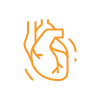Symptoms of Heart Disease
April 11, 2022

Heart disease – Any disease that causes the heart or the blood vessels to fail is known as heart disease. The different types of heart diseases are:
- Coronary Artery disease
- Heart rhythm problems (arrhythmias)
- Congenital heart defects
- Heart valve disease
- A condition of the heart muscle
- Heart infection.
Contents
Each kind of heart disease has a different treatment, but their symptoms may be similar. Some signs of the mentioned heart diseases are:
1. Symptoms of Coronary Artery Disease
Angina is the most common symptom of Coronary Artery disease. Angina is a discomfort, heaviness, pressure, aching, burning, fullness, squeezing, or a harrowing feeling in your chest. This is sometimes mistaken for heartburn or indigestion. Angina may also be felt in the throat, jaw, neck, or back. Some other common symptoms include:
- Shortness of breath
- Palpitations (irregular heartbeats or a “flip-flop” feeling in your chest)
- A faster heartbeat
- Weakness or dizziness
- Nausea
- Sweating
2. Symptoms of Heart rhythm problems (arrhythmias)
Arrhythmia is a disease in which your heart might beat too fast, too slow, or irregularly. Some signs of Heart Arrhythmia are:
- Fluttering in your chest
- Racing heartbeat (tachycardia)
- Slow heartbeat (bradycardia)
- Chest pain or discomfort
- Shortness of breath
- Lightheadedness
- Dizziness
- Fainting or near fainting.
3. Congenital Heart defects
Some severe heart problems you’re born with are usually noticed soon after birth. Symptoms of congenital heart defects are:
- Pale grey or blue skin colour (cyanosis)
- Swelling in the legs, abdomen, or areas around the eyes.
- In an infant, shortness of breath during feedings leads to poor weight gain.
Some less severe congenital heart defects are not diagnosed until later in life. Some of the symptoms of more minor life-threatening heart diseases are:
- Quickly getting short of breath during exercise.
- Quickly tiring during exercise or activity.
- Swelling in the hands, ankles, or feet
Also Read: Immune-Boosting Foods
4. Heart valve disease
A heart consists of 4 valves. The aortic, mitral, pulmonary, and tricuspid valves are responsible for pumping blood to the other parts of the body. Unfortunately, many things can damage any of the four valves leading to narrowing (stenosis), leaking (regurgitation or insufficiency), or improper closing (prolapse).
Some of the symptoms of a heart valve disease, depending on the valve that is not working, are:
- Fatigue
- Shortness of breath
- Irregular heartbeat
- Swollen feet or ankles
- Chest pain
- Fainting (syncope)
5. A disease of the heart muscle
A heart muscle disease is commonly known as cardiomyopathy. At inception, it has no symptoms. But as the condition worsens, the symptoms include:
- Breathlessness with activity or at rest
- Swelling of the legs, ankles, and feet
- Fatigue
- Irregular heartbeats.
- Dizziness, lightheadedness, and fainting.
6. Heart infection
An infection that affects the inner lining of the chambers and valves (Endocardim) is known as Endocarditis. The symptoms of a heart infection are:
- Fever
- Shortness of breath
- Weakness or fatigue
- Swelling in your legs or abdomen
- Changes in your heart rhythm
- Dry or persistent cough
- Skin rashes or unusual spots
7. Four Stages of Heart Disease
There are four stages of heart disease. It ranges from a “high risk of developing heart failure” to “advanced heart failure.” They are known as stages A, B, C, and D.
Heart Disease – Stage A:
This is the primary stage of heart disease. Also known as pre-heart failure. This means that you have a high risk of developing heart failure because you have a family history of heart failure, or you might be facing the following symptoms,
- Hypertension.
- Diabetes.
- Coronary artery disease.
- Metabolic syndrome.
- History of alcohol abuse.
- History of rheumatic fever.
- Family history of cardiomyopathy.
Read Also: What is a Heart Transplant?
Heart Disease – Stage B:
This category includes heart failure people and reduced EF (HF-rEF) due to any cause. In addition, this category includes people who have been diagnosed with systolic left ventricular dysfunction but never had any symptoms of heart failure.
Heart Disease – Stage C:
People with Stage C heart failure have already been diagnosed with heart failure. Therefore, they are most likely to have had these symptoms in the past.
- Shortness of breath.
- Feeling tired (fatigue).
- Less able to exercise.
- Weak legs.
- Waking up to urinate.
- Oedema.
Heart Disease – Stage D:
People with Stage D heart failure have advanced symptoms that don’t get better with treatment. This is the last stage of heart failure.
People also ask
1. How do I check myself for heart disease?
A regular pulse is about 60 to 100 heartbeats per minute. To check your pulse, place your index and middle finger of your hand on the hollow part of your inner wrist of the other arm, just below the base of the thumb. You should feel a tapping or pulse against your fingers. That is your heartbeat. Look at your watch and count the number of taps you feel in 10 seconds. Multiply that number by 6 to find your pulse for a minute. Check your pulse if you feel like you have symptoms of heart disease like Chest pain, pressure, or being short of breath.
2. How can I check my heart health?
Some of the best ways to check your heart health are:
- Blood tests
- Electrocardiogram (ECG)
- Exercise stress test
- Echocardiogram (Ultrasound)
- Nuclear cardiac stress test
- Coronary Angiogram
- Magnetic resonance imaging (MRI)
- Coronary computed tomography angiogram (CCTA)








